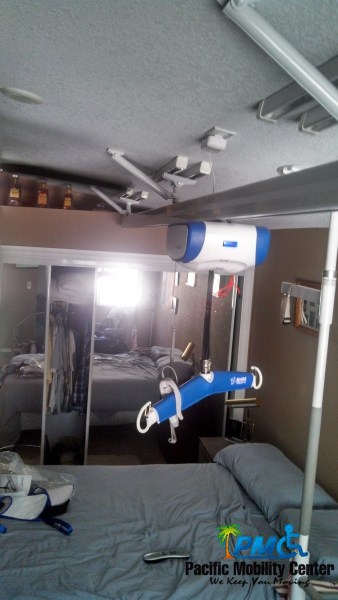Keep safe patient handling in mind when deciding between a ceiling lift versus a floor lift. The pros and cons of both are contingent on the user, the caregiver, and the living situation.
Transporting someone with a physical impairment or disability can pose hazards to both the individual and the caregiver, as well as run the risk of significant injury. There are numerous mobility devices and aids that can make this process simpler and less-dangerous,
Make safety the priority
Safe Patient Handling refers to protecting both the patient and the caregiver with safe transport methods. Equipment and mobility aids, such as lifts, are fast-becoming an integral component of patient care in hospitals and skilled-nursing settings. Training curriculums often address the principles of good-body mechanics, which decreases the risk of an injury during transports or ADLs (activities of daily life), like bathing or dressing. Implement these same strategies at home to preserve autonomy and to enhance safety when working with individuals that have physical limitations or disabilities.
Ceiling Lift versus Floor Lift: The Pros and Cons of Both:
Talk with a reputable and certified retailer of mobility aids and devices for a thorough nneeds assessment which will indicate the most pragmatic options for you. Furthermore, resist buying second-hand devices from private sellers, as these will not be backed by any type of warranty, support, or service after the sale. Buying from a qualified vendor ensures professional installation and customer satisfaction. Before making purchase decisions, consider the differences and distinctions of these two very-different accessibility aids.
Ceiling Lifts
Ceiling lifts are often seen in skilled nursing settings, and may be the contraption that you see installed overhead when visiting patients or sitting bedside. A tracking system is installed for the lift to run on during transfers and transports, and the tracking is usually secured to the ceiling, itself, or mounted to a wall. Some ceiling lifts are free standing systems, which often resemble a floor lift although the stabilization or support may differ. Consumers and caregivers seeking assistance with daily routines and ADLs often opt for ceiling lifts, which provide a sense of safety and peace of mind, but there are other factors that may make this device less practical for some households. Interested buyers should meet with reputable merchants for an assessment of needs, product information, and price estimates before making purchase decisions.
Some pros and cons of ceiling lifts include:
- Ceiling lifts are deemed easier to utilize than floor lifts in skilled nursing settings where patients are routinely moved.
- Consumers will pay for the convenience of ceiling lifts, as these are typically more expensive than floor lifts.
- Ceiling lifts offer a wider-range of options and movement than floor lifts. Patients can be raised, lowered, lifted, and rolled using a ceiling lift.
- Ceiling lifts- that are installed- don’t require storage space or take up room in small quarters.
Floor Lifts
Floor lifts are an interesting concept. While the name implies that the device raises and lowers the ground, what it actually does is create a hoist to raise the patient above the floor- wherever they happen to be. These devices provide a lower center of gravity and fulcrum for the transport, similar to the role of a ceiling with a ceiling lift. It always makes the most sense to discuss your options with providers and equipment vendors to ensure you are getting the right device for your needs, living situation, and budget.
Some pros and cons of floor lifts are:
- Floor lifts require more exertion to complete the transport than a ceiling lift. Typically, it takes more than one caregiver to lift or move a patient with a floor lift as opposed to a single caregiver to assist with a ceiling lift.
- Floor lifts are mobile, able to easily move from room-to-room, but take up more space than an installed ceiling lift does.
- Floor lifts are cost-efficient, making it feasible to increase access and ease at a lower price point.
- Floor lifts can be taken on vacation, during respite stays, or to another setting, in the event that the patient or user leaves their home. Ceiling lifts would require professional uninstallation and reinstallation.
Consider Both Patients and Caregivers
Keep in mind that mobility aids are intended for both consumers and those providing care for them, further reinforcing the prudence and practicality of such purchases. These expenditures will enhance access, autonomy, and quality of life for the user, while also providing reassurance, convenience, and safety for caregivers and loved ones.
Floor lifts versus ceiling lifts? The choice is ultimately up to you. Remember that the key for long-term satisfaction is to buy mobility aids from dealers who will stand behind their product and guide you as you adapt and adjust to mobility aids. Accessibility equipment, such as lifts, are a win-win situation!
President, Husband, Father, Grandfather Graduate of UC Davis- Bio Sci Major- Go Aggies! Jeff has extensive experience in all of Pacific Mobility’s products and services, and specializes in accessibility products as well as stairlifts, ceiling lifts and custom wheel chairs. His hobbies include spending time with family, gardening, mountain biking, exercising and off road motorcycle riding.
24 years as Owner/President of Pacific Mobility Center – selling, installing, and servicing stairlifts, porch lifts, ceiling lifts, pool lifts, handicap ramping, specialty wheelchairs, scooters, power wheel chairs, and other power mobility devices
Certified Environmental Access Consultant since 2008
Licensed General Contractor since 1998
Certified Aging in Place Specialist since 2016
Board Member for Home Access Professionals
Member of Association of Members of the Accessibility Equipment Industry (AEMA)




